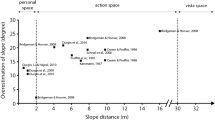Abstract
When remotely navigating a mobile robot, operators must estimate the slope of local terrain in order to avoid areas that are too steep to climb or that slope so steeply downward that the operator would lose control of the rover. Although many rovers are equipped with sensor systems to aid the operator in this task, it is sometimes necessary to estimate slopes from two-dimensional images, either when planning operations or when the operator wishes to monitor the results of a sensor system. This experiment compares the operator’s estimates of the slope in Martian terrain with the actual slope determined from three-dimensional data. The ten participants overestimated the slope of the indicated regions by an average of 19° (SD 16°). An analytic model of the error, based on psychophysical analysis, accurately predicts the average magnitude of the errors. Implementation of this model eliminates an average amount of participant error. However, the large estimate variance within and between participants and images still poses a challenge for accurate slope estimation.
Similar content being viewed by others
References
Burke, J., Murphy, R., Coovert, M., Riddle, D.: Moonlight in Miami: field study of human–robot interaction in the context of an urban search and rescue disaster response training exercise. Hum. Comput. Interact. 19(1), 85–116 (2004)
Casper, J., Murphy, R.: Human–robot interactions during the robot-assisted urban search and rescue response at the World Trade Center. IEEE Trans. Syst. Man Cybern. Part B Cybern. 33(3), 367–385 (2003)
Creem-Regehr, S.H., Gooch, A.A., Sahm, C.S., Thompson, W.B.: Perceiving virtual geographical slant: action influences perception. http://www.psych.utah.edu/∼sc4002/pubs.htm (2003). Accessed 27 January 2004
Drury, J., Scholtz, J., Yanco, H.: Awareness in human–robot interactions. In: IEEE International Conference on Systems, Man and Cybernetics (2003)
Epstein, W., Park, J.: Gibson’s psychophysical hypothesis. Psychol. Bull. 62(3), 180–196 (1964)
Gibson, J.J.: The perception of visual surfaces. Am. J. Psychol. 63, 367–384 (1950)
Kanduri, A.K., Thomas, G., Cabrol, N., Grin, E., Anderson, R.C.: The (in)accuracy of novice rover operators’ perception of obstacle height from monoscopic images. IEEE Trans. Syst. Man Cybern. Part A 35(4), 505–512 (2005)
Lewis, M., Wang, J., Hughes, S., Liu X.: Experiments with attitude: attitude displays for teleoperation. In: IEEE International Conference on Systems, Man and Cybernetics (2003)
NASA: Planetary Data System Database, Mars Pathfinder IMP imager, Presidential Panorama. http://stardev.jpl.nasa.gov/pds/index.jsp (2003). Accessed 11 November 2003
Perrone, J.A.: Slant underestimation: a model based on the size of the viewing aperture. Perception 9, 285–302 (1980)
Perrone, J.A.: Visual slant underestimation: a general model. Perception 11, 641–654 (1982)
Perrone, J.A., Wenderoth, P.M.: Visual slant underestimation. In: Ellis, S.R. (ed.) Pictorial Communication in Virtual and Real Environments, pp. 496–503. Taylor & Francis, London (1981)
Proffitt, D.R., Bhalla, M., Gossweiler, R., Midgett, J.: Perceiving geographical slant. Psychon. Bull. Rev. 2(4), 409–428 (1995)
Proffitt, D.R., Creem, S.H., Zosh, W.D.: Seeing mountains in mole hills: geographical-slant perception. Psychol. Sci. 12(5), 418–423 (2001)
Sheridan, T.: Telerobotics, Automation, and Human Supervisory Control. MIT Press, Cambridge (1992)
Smith, A.H.: Outline convergence versus closure in the perception of slant. Percept. Mot. Skills 9, 259–266 (1959)
Steinfeld, A.: Interface lessons for fully and semi-autonomous mobile robots. IEEE Int. Conf. Robot. Autom. 3, 2752–2757 (2004)
van Erp, J.: Trade-offs between spatial and temporal resolution in driving unmanned ground vehicles. In: Proceedings of the Human Factors and Ergonomics Society 42nd Annual Meeting, pp. 1550–1554 (1998)
Woods, D.D., Tittle, J., Feil, M., Roesler, A.: Envisioning human–robot coordination in future operations. IEEE Trans. Syst. Man Cybern. Part C 34(2), 210–218 (2004)
Author information
Authors and Affiliations
Corresponding author
Rights and permissions
About this article
Cite this article
Xiang, Z., Thomas, G.W., Thornburg, K.M. et al. Slope Perception from Monoscopic Field Images: Applications to Mobile Robot Navigation. J Intell Robot Syst 54, 595–612 (2009). https://doi.org/10.1007/s10846-008-9281-y
Received:
Accepted:
Published:
Issue Date:
DOI: https://doi.org/10.1007/s10846-008-9281-y




